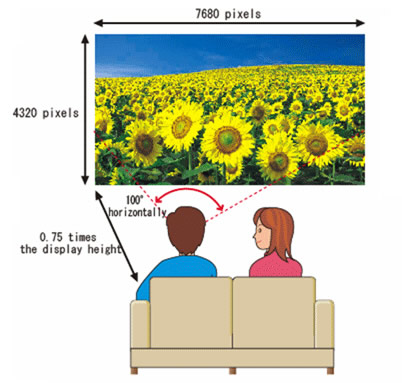
NHK Showcases The Future of Ultra High Definition Imaging Technologies
Japan Broadcasting Corporation (NHK) and its Science and Technical Research Laboratories (STRL) present the future of digital imaging technologies and broadcasting at the Open House 2008 show in Tokyo, Japan.
The show, which will officially kick off on Thursday, showcases various future concepts related to techniques for ultra-high definition TV broadcastings, HD video capturing and projection systems, advanced image sensor technologies and many more.
Super Hi-Vision (SHV) System
The Super Hi-Vision (SHV) system is among the most impressive concepts of the show. It includes a huge 450" display that is capable of holding ultrahigh-definition images at a resolution of 7,680 ? 4,320, which is four times higher than the current HDTV systems. The system supports a refresh rate of 60Hz, Coupled with a 22.2 multi-channel sound, the system conveying a strong sensation of reality.

The system has been also showcased at NEB, CEATEC and IBC shows in the past. Its video format has been standardized as an international standard (ITU-R BT.1769), and NHK plans to further enhance the resolution of the imaging/display system, as well as its tone reproduction, to attain the full potential of SHV video.

A single Super Hi-Vision (SHV) video frame consists of approximately 33 million (7680 ? 4320) pixels. Recently, NHK constructed a prototype 33M-pixel image sensor, and captured moving picture video with it. Before this development, there was no image sensor capable of shooting a moving picture at this resolution; the conventional method of shooting SHV video was through a camera using a four-imager pickup system with an off set of half a pixel pitch in the diagonal direction.
The incorporation of CMOS technology made it feasible to integrate new functions in the image sensor, including high-speed and high-data rate signal output and on-chip analog-to-digital conversion.
After considering all aspects of camera performance, including lens resolution and size, image sensor sensitivity, and dynamic range, NHK determined that the pixel size should be 3.8μm square.
For the live presentation, NHK used a special High Dynamic Range projector. The key for succeeding quality projection of SHV video in a darkened room like a home theater is the use of a method for reproducing black with a high contrast ratio. Although conventional projectors have contrast ratios in the range of several thousand to one, NHK has developing display devices that will have dramatically higher contrast ratios.
The display system projects the optical output from an ordinary RGB projector onto a panel for luminance, followed by luminous modulation. This attenuates the incident light in two stages to create the black areas in an image, reproducing a darker black.
A contrast ratio of approximately 1 million to one has been attained. Tone reproduction especially in dark areas has been improved. Since the human visual system has a lower color resolution in comparison to luminance, a high resolution image can be displayed by increasing just the resolution of the second modulator panel for luminance and keeping the RGB projector display device for the first modulator at low resolution.
Victor Company of Japan (JVC) is responsible for the research in this area, occupied with research on signal processing methods to convert an ordinary video signal into an RGB modulated signal and a luminance modulated signal for this system. The goal is to create a projector for an SHV system.
Broadcasting of SHV Content
Super Hi-Vision (SHV) broadcasting was brought a step closer to reality with the development of an advanced video compression codec system.
This real-time coding/decoding prototype based on the MPEG-4 AVC/H.264 coding scheme is the first of its kind for SHV video. It estimates the coding complexity for input video before the actual coding process, and it minutely controls the allotment of information. As a result, it can compress data to one hundredth or one two hundredth its original size, while maintaining the quality of the SHV video.
The codec compresses an SHV video signal to 1/100th to 1/200th its original data size. Parallel coding units could enable real-time coding of 24-Gbps SHV video signals.
The Open House Show will be held at NHK STRL Auditorium in Tokyo, Japan, May 22~25.
Super Hi-Vision (SHV) System
The Super Hi-Vision (SHV) system is among the most impressive concepts of the show. It includes a huge 450" display that is capable of holding ultrahigh-definition images at a resolution of 7,680 ? 4,320, which is four times higher than the current HDTV systems. The system supports a refresh rate of 60Hz, Coupled with a 22.2 multi-channel sound, the system conveying a strong sensation of reality.

The system has been also showcased at NEB, CEATEC and IBC shows in the past. Its video format has been standardized as an international standard (ITU-R BT.1769), and NHK plans to further enhance the resolution of the imaging/display system, as well as its tone reproduction, to attain the full potential of SHV video.

A single Super Hi-Vision (SHV) video frame consists of approximately 33 million (7680 ? 4320) pixels. Recently, NHK constructed a prototype 33M-pixel image sensor, and captured moving picture video with it. Before this development, there was no image sensor capable of shooting a moving picture at this resolution; the conventional method of shooting SHV video was through a camera using a four-imager pickup system with an off set of half a pixel pitch in the diagonal direction.
The incorporation of CMOS technology made it feasible to integrate new functions in the image sensor, including high-speed and high-data rate signal output and on-chip analog-to-digital conversion.
After considering all aspects of camera performance, including lens resolution and size, image sensor sensitivity, and dynamic range, NHK determined that the pixel size should be 3.8μm square.
For the live presentation, NHK used a special High Dynamic Range projector. The key for succeeding quality projection of SHV video in a darkened room like a home theater is the use of a method for reproducing black with a high contrast ratio. Although conventional projectors have contrast ratios in the range of several thousand to one, NHK has developing display devices that will have dramatically higher contrast ratios.
The display system projects the optical output from an ordinary RGB projector onto a panel for luminance, followed by luminous modulation. This attenuates the incident light in two stages to create the black areas in an image, reproducing a darker black.
A contrast ratio of approximately 1 million to one has been attained. Tone reproduction especially in dark areas has been improved. Since the human visual system has a lower color resolution in comparison to luminance, a high resolution image can be displayed by increasing just the resolution of the second modulator panel for luminance and keeping the RGB projector display device for the first modulator at low resolution.
Victor Company of Japan (JVC) is responsible for the research in this area, occupied with research on signal processing methods to convert an ordinary video signal into an RGB modulated signal and a luminance modulated signal for this system. The goal is to create a projector for an SHV system.
Broadcasting of SHV Content
Super Hi-Vision (SHV) broadcasting was brought a step closer to reality with the development of an advanced video compression codec system.
This real-time coding/decoding prototype based on the MPEG-4 AVC/H.264 coding scheme is the first of its kind for SHV video. It estimates the coding complexity for input video before the actual coding process, and it minutely controls the allotment of information. As a result, it can compress data to one hundredth or one two hundredth its original size, while maintaining the quality of the SHV video.
The codec compresses an SHV video signal to 1/100th to 1/200th its original data size. Parallel coding units could enable real-time coding of 24-Gbps SHV video signals.
The Open House Show will be held at NHK STRL Auditorium in Tokyo, Japan, May 22~25.





















